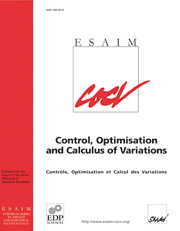Crossref Citations
This article has been cited by the following publications. This list is generated based on data provided by
Crossref.
Cortes, J.
Martinez, S.
and
Bullo, F.
2004.
Coordinated deployment of mobile sensing networks with limited-range interactions.
p.
1944.
Cortes, J.
Martinez, S.
and
Bullo, F.
2005.
Analysis and design tools for distributed motion coordination.
p.
1680.
Martinez, S.
Bullo, F.
Cortes, J.
and
Frazzoli, E.
2005.
On synchronous robotic networks Part II: Time complexity of rendezvous and deployment algorithms.
p.
8313.
Martínez, Sonia
Cortés, Jorge
and
Bullo, Francesco
2005.
ON ROBUST RENDEZVOUS FOR MOBILE AUTONOMOUS AGENTS.
IFAC Proceedings Volumes,
Vol. 38,
Issue. 1,
p.
115.
Ganguli, A.
Susca, S.
Martinez, S.
Bullo, F.
and
Cortes, J.
2005.
On collective motion in sensor networks: sample problems and distributed algorithms.
p.
4239.
Cortes, J.
2005.
Achieving coordination tasks in finite time via nonsmooth gradient flows.
p.
6376.
Cortés, Jorge
2006.
Finite-time convergent gradient flows with applications to network consensus.
Automatica,
Vol. 42,
Issue. 11,
p.
1993.
Cortes, J.
Martinez, S.
and
Bullo, F.
2006.
Robust Rendezvous for Mobile Autonomous Agents via Proximity Graphs in Arbitrary Dimensions.
IEEE Transactions on Automatic Control,
Vol. 51,
Issue. 8,
p.
1289.
Gao, Chunkai
Bullo, Francesco
Cortes, Jorge
and
Jadbabaie, Ali
2006.
Notes on averaging over acyclic digraphs and discrete coverage control.
p.
4651.
Mostofi, Yasamin
and
Murray, Richard M.
2006.
Distributed Sensing and Estimation Under Communication Constraints.
p.
1013.
Li, Yingying
and
Liu, Yun-Hui
2007.
Energy Saving Target Tracking Using Mobile Sensor Networks.
p.
3653.
Li, Yingying
Liu, Yun-hui
and
Xuanping Cai
2007.
Local control strategy for target tracking in mobile sensor networks.
p.
674.
Jongeun Choi
Songhwai Oh
and
Horowitz, Roberto
2007.
Cooperatively learning mobile agents for gradient climbing.
p.
3139.
Clark, Justin
and
Fierro, Rafael
2007.
Mobile robotic sensors for perimeter detection and tracking.
ISA Transactions,
Vol. 46,
Issue. 1,
p.
3.
2007.
Motion Coordination with Distributed Information.
IEEE Control Systems,
Vol. 27,
Issue. 4,
p.
75.
K.R., Guruprasad
and
Ghose, Debasish
2007.
Deploy and Search Strategy for Multi-agent systems using Voronoi partitions.
p.
91.
Martinez, Sonia
2007.
Practical rendezvous through modified circumcenter algorithms.
p.
2369.
Martinez, Sonia
Bullo, Francesco
Cortes, Jorge
and
Frazzoli, Emilio
2007.
On Synchronous Robotic Networks—Part II: Time Complexity of Rendezvous and Deployment Algorithms.
IEEE Transactions on Automatic Control,
Vol. 52,
Issue. 12,
p.
2214.
Kwok, Andrew
and
Martinez, Sonia
2007.
Energy-balancing cooperative strategies for sensor deployment.
p.
6136.
Schwager, Mac
Slotine, Jean-Jacques
and
Rus, Daniela
2007.
Decentralized, Adaptive Control for Coverage with Networked Robots.
p.
3289.


